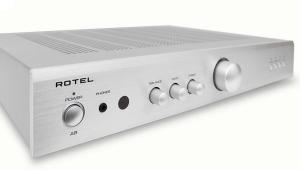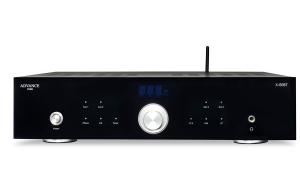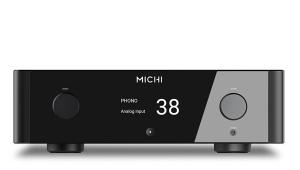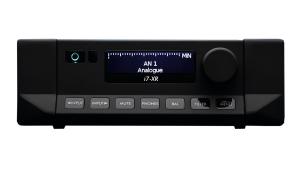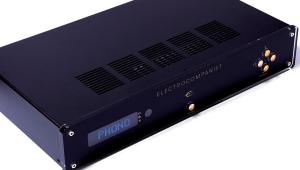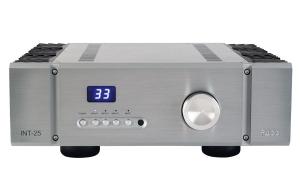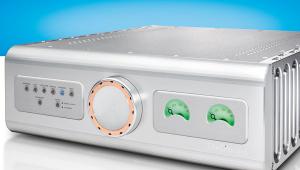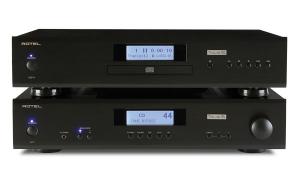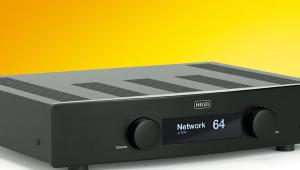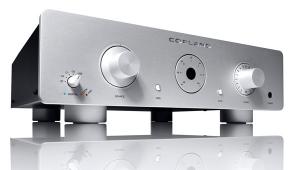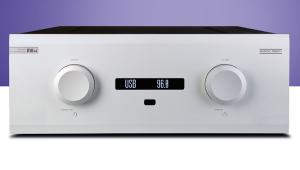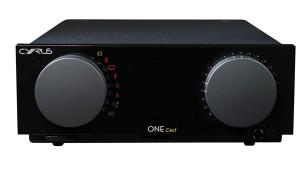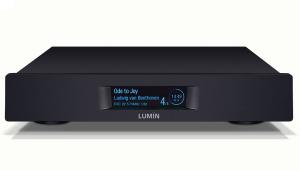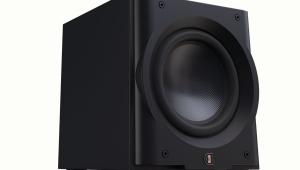Rotel Michi X5
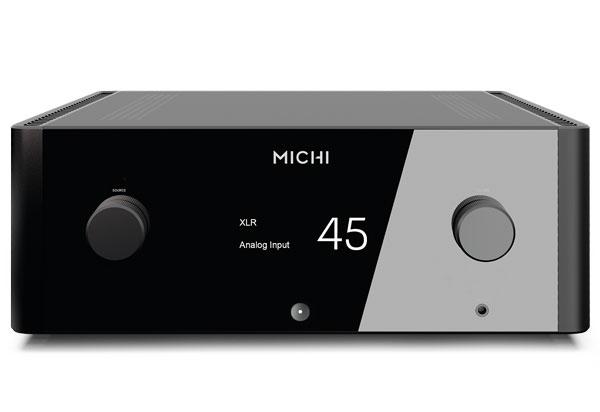
 The Michi X5 is the £6,300 ‘big brother’ of Rotel’s more-affordable £2,000 X3 model and outwardly seems to be the same amplifier literally writ large. It occupies the same 485x452mm footprint, but is 45mm more imposing, at 195mm tall, while the weight is up a hefty 14.9kg, from the substantial 28.9kg of the lesser model to a full 43.8kg. In every respect, this is a big and impressive-looking integrated amplifier, even by the standards set by the imposing but svelte Michi X3.
The Michi X5 is the £6,300 ‘big brother’ of Rotel’s more-affordable £2,000 X3 model and outwardly seems to be the same amplifier literally writ large. It occupies the same 485x452mm footprint, but is 45mm more imposing, at 195mm tall, while the weight is up a hefty 14.9kg, from the substantial 28.9kg of the lesser model to a full 43.8kg. In every respect, this is a big and impressive-looking integrated amplifier, even by the standards set by the imposing but svelte Michi X3.
In return for all this you get some added facilities and even more impressive power output specifications: the X3 claims 200W/8ohm and 350W/4ohm and the X5 promises 350W/8ohm, rising to a whopping 600W/4ohm, all comfortably exceeded in practice. The X5 has an additional unbalanced analogue line-in, bringing the total to four, plus one set of balanced inputs. The extra input is labelled ‘Aux 2’ though all inputs can be relabelled for the front panel display via the extensive menu system. There’s also MC phono capability as well as the MM included on the junior amp.
Again, this switching is carried out deep in the menus, along with the ability to skip unused inputs when scrolling through them, to decide whether or not tone controls will be applied to a specific input, and set a fixed level for a particular input. We would once have said this was useful when using the amplifier with the front left/right pre outs of an AV receiver or processor to integrate it into a surround system. These days it’s just as relevant if the amp is paired with a component that has its own volume control, such as a smartphone or tablet used to stream music. The Michi X5 may be aimed high, as that price-tag suggests, but it’s also designed with all the flexibility required of modern audio systems.
Along with this raft of digital inputs, including USB-B for computer connection plus three optical and three coaxial sockets, there’s also a little slab-shaped antenna on the rear panel offering Bluetooth wireless connectivity. The latter comes with AAC and aptX compatibility.
In fact, the only disappointment – for some at least – will be the thwarted promise of its USB-A and Ethernet ports. These are for firmware updates, the USB-A also offering 5V power for external devices and the Ethernet control of the amp over a network, but neither supports music playback.
An external IR receiver is also supported, should you wish to hide away all the amp’s black gloss loveliness, while 12V trigger ports allow the X5 to be integrated into a broader set-up. There’s also an RS232 port for more custom-installation control.
As on the X3, the two sets of speaker terminals are paralleled and designed to bi-wire a single pair of suitable speakers. A pair of pre-outs are provided should you wish to add an external amplifier for bi-amping your speakers, and there are two mono subwoofer outputs, plus a headphone socket on the front panel. Also retained from the X3 is the simple fascia, with little more than source and volume controls, and a big, ultra-clear display complete with VU meters and spectrum analyser readouts. Should you want to go for the full moody black look, the display can be dimmed or turned off from the excellent remote common to all Michi integrateds and the P5 preamp. It’s a solid little device, and a masterpiece of clarity – you can even temporarily adjust tone and balance without leaving your seat!
Sound quality
As the X3 had proved so impressive, I approached the X5 with some trepidation that any notional gains offered by the X5 might be merely incremental, rather than revelatory. In the event I needn’t have worried, not only did the X5 show itself to be different, it proved unlike the X3 to a surprising degree. The big, bold, and yet sprightly and wide-open sound of the ‘lower-powered’ amp was replaced by a softer, slightly darker presentation here. The bigger Michi X5 undoubtedly has a superb ability to go loud while maintaining full control of the speakers, and with typically startling dynamic ability both on the micro and macro scales, but its sound didn’t move me as much as the X3. This is a highly impressive amplifier, without doubt, but a spine-tingler? Not quite…
Playing the Jerry Junkin/Dallas Winds recording of the march from Steven Spielberg’s 1941, an exuberant piece of scoring by John Williams, with massive dynamics across and within the track, the X5 displays that darker, ‘of a piece’ sound, with diminished instrumental detail and texture and greater emphasis on the scale of the massed forces as the track builds. With more Williams, in the form of David Helbock’s solo piano on The Duel Of The Fates from Playing John Williams, the Michi X5, here driving Bowers & Wilkins 800 D3 loudspeakers, manages to sound rather distant with this close-up production. The presentation is certainly fast and hard-hitting, but at the same time lacking some ambience.
A recording like Till Brönner’s The Good Life seems slap bang in the middle of the X5’s aspirational ballpark with its gorgeous centre stage and simple bass/drums/piano backing ranged behind it. Drums patter and swish back there, and the bass has fine definition and resonance. In truth, this album is hardly demanding, but it sounds magnificent here.
The X5 comes across as rather more programme-dependent tan the X3, even if it’s hard to pinpoint exactly why. With the Jared Sacks recording of the Oyster Duo’s Stolen Pearls recital there’s the odd effect of Nicky Schwartz’s double-bass dominating the piano of his wife, Anna Fedorova, and for all the weight and resonance of the double-bass here, the two sound like they’re playing some way away with the surrounding acoustic tending to swallow them up. Of course, sometimes this slight lack of ambience can help – or at least change – the sound of a recording. For example, John Challenger’s beautiful Salisbury Meditation recital is curated from 270 hours of live recordings made while the newly-restored organ was played in Salisbury Cathedral during the on-site Covid-19 vaccinations – the ambience of the instrument accompanied by the hushed bustle going on down in the cathedral’s nave. Via the X5, there’s still a fine sense of the instrument in the lofty space, but that rustle of atmosphere is somewhat diminished, which is a good thing for focus on the playing, but it may rob the recordings of a little of their magic.
The rendition of The Waterboys’ This Is The Sea on Tom Jones’s Surrounded By Time shows much of the dichotomy of the sound here, for the track still sounds big and bold even if the octogenarian singer should be delivered with more deep-chested power. The track has good dynamics, and a decent swagger, but it needs more guts, and only really focuses when the mix drops down to the more restrained final section. Other distinctive voices were also rendered differently: Iggy Pop’s guest vocal on Why Can’t We Live Together?, from Dr Lonnie Smith’s Breathe album is understated, agreed, but here it’s arguably a little too, well, submerged. By contrast, Smith’s Hammond is rendered magnificently, and with so much detail that you can almost hear the tonewheel ‘biting’ with the magnets to switch on each note. Without question, that element of the track remains utterly spellbinding.
Conclusion
Nevertheless, while impressive enough in its own right, the Michi X5 still lacks a little of the sparkle and surprise of its junior X3 stablemate. And that, in essence, is this amplifier’s headache: grand though the X5 is, the X3 delivers a magical performance for a healthy £2,000 less, offers almost all the bigger amp’s flexibility and is also less space-hungry. That makes the more affordable model in Rotel’s Michi range its star buy. HFC
DETAILS
Product: Rotel Michi X5
Type: Integrated amplifier
FEATURES
● MM/MC phono
● USB and S/PDIF digital inputs
● Dual 4mm speaker outlets for bi-wiring
 |
Inside this month's issue:
Ruark R610 music system and Sabre-R standmount speakers, PMC twenty.23i Active, floorstanders, English Acoustics Downton preamplifier, Bluesound NODE ICON preamp/streamer, Ortofon Concorde Music Blue MM cartridge and much, much more
|
